Hiking Skirt Guide: Choosing, Styling, and Maximizing Your Trail Experience
Hello, fellow trailblazers! Have you ever considered swapping out your usual hiking pants or shorts for a skirt? If not, allow me to introduce you to the wonders of hiking skirts.
The Rise in Popularity of Hiking Skirts
In recent years, hiking skirts have transitioned from a niche item to a hiking trail favorite. And why? They offer unparalleled freedom of movement and a fresh, breezy alternative, especially on warm days.
Advantages of Opting for a Hiking Skirt
Hiking skirts are more than just a fashion statement on the trails; they offer a plethora of benefits that enhance the hiking experience in various ways. From providing exceptional freedom of movement to offering health benefits and versatility, the decision to wear a hiking skirt can significantly impact your comfort and enjoyment during outdoor adventures. Let’s delve deeper into the advantages of opting for a hiking skirt.
Freedom of Movement
One of the most immediate benefits of wearing a hiking skirt is the unparalleled freedom of movement it provides. Hiking involves a variety of physical activities that require flexibility and ease of movement, such as:
- Ascending Steep Trails: Climbing uphill can be strenuous, and a hiking skirt allows for a broader range of motion without the constraints that pants might impose.
- Jumping Over Brooks: When facing water streams or small obstacles, the flexibility to jump freely is crucial, and skirts facilitate this agility.
This advantage is particularly significant for hikers who prioritize comfort and mobility on their journeys, making hiking skirts an excellent choice for those looking to enhance their hiking experience.
Health Benefits
Beyond the practicality in movement, hiking skirts offer several health benefits that make them a superior choice for some hikers:
- Improved Airflow: The design of hiking skirts promotes better air circulation around the lower body, which is especially beneficial for individuals prone to yeast infections. The increased ventilation helps to maintain a dry and cool environment, reducing the risk of infections.
- Prevention of Thigh Chafing: Thigh chafing is a common issue for hikers, particularly on longer treks. Hiking skirts can help prevent this uncomfortable condition by reducing friction and allowing air to circulate freely, thereby minimizing the risk of chafing.
UV Protection
Many hiking skirts on the market are designed with built-in UPF (Ultraviolet Protection Factor), which provides a layer of protection against the harmful effects of the sun’s rays. This feature is incredibly beneficial for outdoor enthusiasts who spend extended periods in direct sunlight. The UPF rating indicates how much of the sun’s UV radiation is absorbed by the fabric, thus protecting the skin underneath from exposure. Opting for a hiking skirt with a high UPF rating can significantly reduce your risk of sunburn and long-term skin damage.
Versatility
One of the most appealing aspects of hiking skirts is their versatility. Unlike traditional hiking attire, which may not transition well to other settings, hiking skirts offer a stylish and comfortable option that can be worn in various social situations. This versatility means that after a day on the trails, you can seamlessly transition to:
- Cafés: Enjoy a relaxing meal or a cup of coffee without the need to change.
- Casual Gatherings: Attend a post-hike get-together or a casual outing with friends, feeling comfortable and appropriately dressed.
This ability to transition effortlessly from outdoor adventures to everyday life makes hiking skirts a practical and fashionable choice for those who value both functionality and style.
Materials and Fabrics to Consider for Your Hiking Skirt
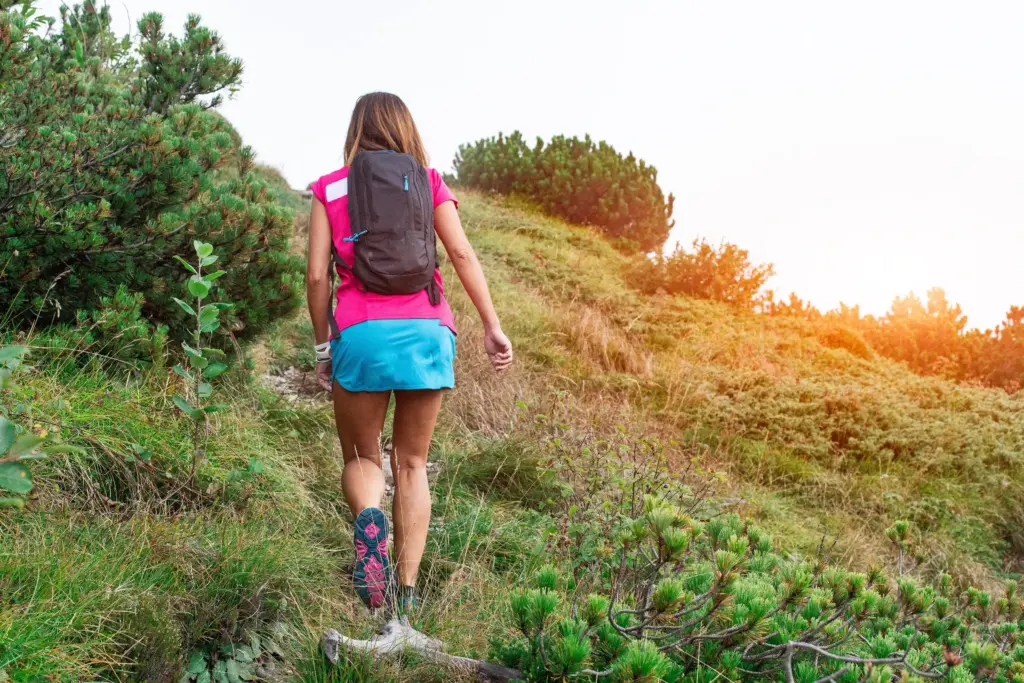
When selecting a hiking skirt, the choice of material is paramount, impacting not just the comfort but also the functionality and adaptability of the garment to various hiking conditions. The right fabric can enhance your hiking experience by providing necessary protection against the elements, ensuring durability, and offering comfort through breathability and moisture management. Here’s a detailed guide on the materials and fabrics to consider for your hiking skirt, tailored to meet the needs of outdoor enthusiasts.
Nylon
Nylon stands out for its lightweight nature and exceptional quick-drying capabilities, making it an excellent choice for hiking in wet conditions or when you’re likely to encounter water. Its key characteristics include:
- Lightweight: Easy to pack and carry, adding minimal weight to your hiking gear.
- Fast-Drying: Quickly moves moisture away from the body and dries, keeping you comfortable.
- Durability: Resistant to tears and abrasions, making it suitable for rugged terrains.
However, nylon’s breathability might not match that of other fabrics, which can be a consideration in very hot weather.
Polyester
Polyester is a popular choice among hikers due to its versatility and performance features, such as:
- Breathability: Allows air to circulate, helping to regulate body temperature.
- Moisture-Wicking: Draws sweat away from the body, keeping you dry and comfortable.
- UV-Resistance: Offers protection against the sun’s harmful rays, an essential feature for outdoor activities.
Polyester’s durability and easy-care nature make it a practical option for frequent hikers.
Merino Wool Blends
For those hiking in cooler climates, or for whom comfort and odor control are paramount, Merino wool blends are an ideal choice. These blends combine the natural benefits of Merino wool with the durability and elasticity of synthetic fibers, offering:
- Temperature Regulation: Keeps you warm in cold conditions and cool in warm conditions.
- Odor-Resistance: Natural antimicrobial properties help prevent odor buildup.
- Breathability and Moisture Management: Moves moisture away from the skin and allows air to flow, keeping you dry and comfortable.
Merino wool blends provide natural UV protection, adding an extra layer of defense against sun exposure.
Spandex/Elastane
Spandex or elastane is rarely used alone but often blended with other fabrics to introduce stretch and flexibility, enhancing the fit and movement of the hiking skirt:
- Flexibility: Offers a greater range of motion and comfort during physical activity.
- Fit: Ensures a better fit, accommodating a wider range of body types and movements.
- Durability: Adds strength and longevity to the fabric, maintaining the shape and fit over time.
The inclusion of spandex or elastane makes hiking skirts more adaptable to diverse hiking activities, ensuring comfort without sacrificing performance.
Breathable Fabrics and Weather-resistant Materials
In addition to the specific materials mentioned, it’s crucial to look for fabrics that offer breathability and moisture-wicking properties, essential for maintaining comfort during strenuous activities. Furthermore, consider hiking skirts featuring weather-resistant materials or treatments:
- Durable Water Repellent (DWR) Finish: Provides an additional layer of protection against light rain and moisture, keeping you dry during unexpected weather changes.
- Wind Resistance: Some fabrics offer a degree of wind protection, useful in exposed or high-altitude areas.
Key Features in a Hiking Skirt
When embarking on outdoor adventures, the functionality and comfort of your attire are as crucial as your gear. A great hiking skirt transcends basic fabric choices, incorporating specific features that enhance its practicality, durability, and comfort. Here’s an in-depth look at the key features that set high-quality hiking skirts apart, making them a favored choice for hikers who value performance and style.
UV Protection
Exposure to the sun’s harmful UV rays is a significant concern for outdoor enthusiasts. Many hiking skirts offer UPF (Ultraviolet Protection Factor) protection, which is akin to sunscreen for your clothing. A high UPF rating means more UV protection, essential for preventing sunburn and long-term skin damage during sunny hikes.
Anti-odor Properties
Materials like Merino wool naturally resist odors, making them ideal for multi-day hikes where washing facilities are scarce. Synthetic fabrics can also be treated with antimicrobial properties to combat odor, ensuring freshness throughout your journey.
Adjustable Features
Adjustable features such as drawstrings, Velcro patches, or elastic bands allow for a personalized fit, accommodating fluctuations in body size or preference for tightness. This adaptability ensures comfort and security on varied terrains.
Built-in Shorts
A hiking skirt with built-in shorts offers a combination of comfort and modesty, particularly during high-intensity activities or when navigating challenging terrains. This feature also prevents chafing, adding to the functionality of the skirt.
Pockets and Storage
Pockets are indispensable for carrying essentials like keys, a smartphone, or small tools. Zippered pockets offer secure storage, ensuring your valuables are safe and accessible. The addition of pockets transforms a simple skirt into a practical garment for hiking.
Adjustable Waistbands
An adjustable waistband is key to ensuring your hiking skirt stays comfortably in place, regardless of the activity intensity or the terrain. Whether through elastic, drawstrings, or other mechanisms, the ability to adjust the waistband contributes significantly to the skirt’s overall comfort and utility.
Ventilation and Airflow
Proper ventilation is crucial for maintaining comfort during hikes, especially in warm or humid conditions. Features like side slits or mesh panels enhance airflow, promoting breathability and helping to regulate body temperature.
Pairing Your Hiking Skirt with Other Gear

Optimizing your hiking attire by coordinating your hiking skirt with the appropriate gear not only enhances your overall hiking experience but also ensures you’re prepared for various terrains and weather conditions. Whether you’re trekking through rugged landscapes or enjoying a casual day hike, understanding how to effectively match your hiking skirt with other pieces of gear can significantly impact your comfort, mobility, and protection on the trail. Here’s how to pair your skirt with other essential hiking gear for an optimal outdoor adventure.
Seasonal Pairing
- Cooler Weather: During the colder months, it’s essential to layer effectively. Pair your hiking skirt with moisture-wicking leggings or tights to keep your legs warm while ensuring sweat is drawn away from the skin. Add a thermal base layer on top for added warmth, and consider a wind-resistant or waterproof jacket to protect against the elements.
- Summer Hiking: For warmer weather, opt for a lightweight, breathable top to pair with your hiking skirt. Materials like polyester or Merino wool are excellent for moisture management and keeping you cool. A hat and sunglasses will also complement your outfit and provide necessary protection from the sun.
Safety Gear
- Rugged Terrains: When navigating through challenging terrains that might put you at risk of scrapes and bruises, consider pairing your hiking skirt with protective gear. Knee pads can be worn underneath the skirt to offer protection without compromising on the outfit’s aesthetics. Additionally, wearing a pair of durable gaiters can protect your lower legs from brush and briers.
Footwear
- Choosing the Right Shoes: The right footwear is crucial for any hiking expedition. When wearing a hiking skirt, low-profile shoes or trail runners can offer a more streamlined and lightweight option, perfect for less technical trails. These shoes are designed for comfort and will complement the casual, versatile look of a hiking skirt.
- For More Demanding Hikes: For hikes that demand more from your footwear, such as rocky, uneven terrains or steep inclines, opt for hiking boots that offer more support and protection. Ensure that the boots are well-fitted and provide adequate ankle support. The key is to balance the functionality of your footwear with the style and comfort of your hiking skirt, ensuring that your choice is suitable for the hike’s demands.
Additional Tips for Gear Coordination
- Accessories: Don’t forget to accessorize appropriately. A lightweight backpack that matches your hiking skirt not only adds to your style but also provides practical storage for essentials. Hydration packs are also a great accessory for longer hikes, ensuring easy access to water without having to stop and search through your bag.
- Color Coordination: While functionality is the priority, coordinating the colors of your gear can enhance your hiking experience by making you feel more put-together. Choose gear in complementary colors or patterns to create a cohesive look.
Product Review: Hiking Skirt Alternatives
Hiking skirts have become increasingly popular for their comfort and versatility on the trails. Let’s explore six different products, highlighting their pros and cons to help you find the perfect hiking skirt for your next adventure.
1. ANIVIVO Women’s Golf Skorts Skirts
The ANIVIVO Women’s Golf Skorts Skirts blend functionality with style, making them suitable for various outdoor activities.
Pros:
- Made from quick-dry fabric (88% Nylon, 12% Spandex) which is lightweight and moisture-wicking.
- Features multiple pockets including two front pockets, one zippered back pocket, and a concealed inside pocket for valuables.
- Inner shorts design provides comfort and coverage.
- Zipper button closure with an elastic waistband for a snug fit.
Cons:
- The mini length might not offer sufficient protection in dense underbrush or cooler conditions.
- Limited color options may not appeal to all preferences.
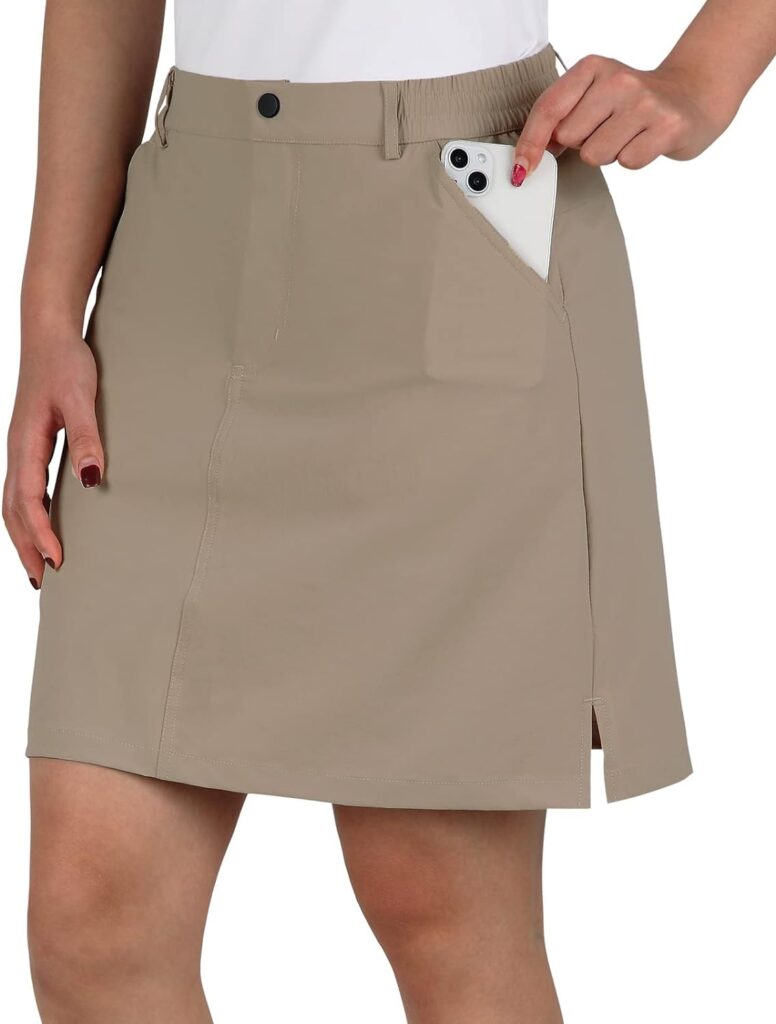
2. BALEAF Women’s 17″ Puffer Quilted Skirt
The BALEAF Puffer Quilted Skirt is designed for cold-weather activities, providing insulation and style.
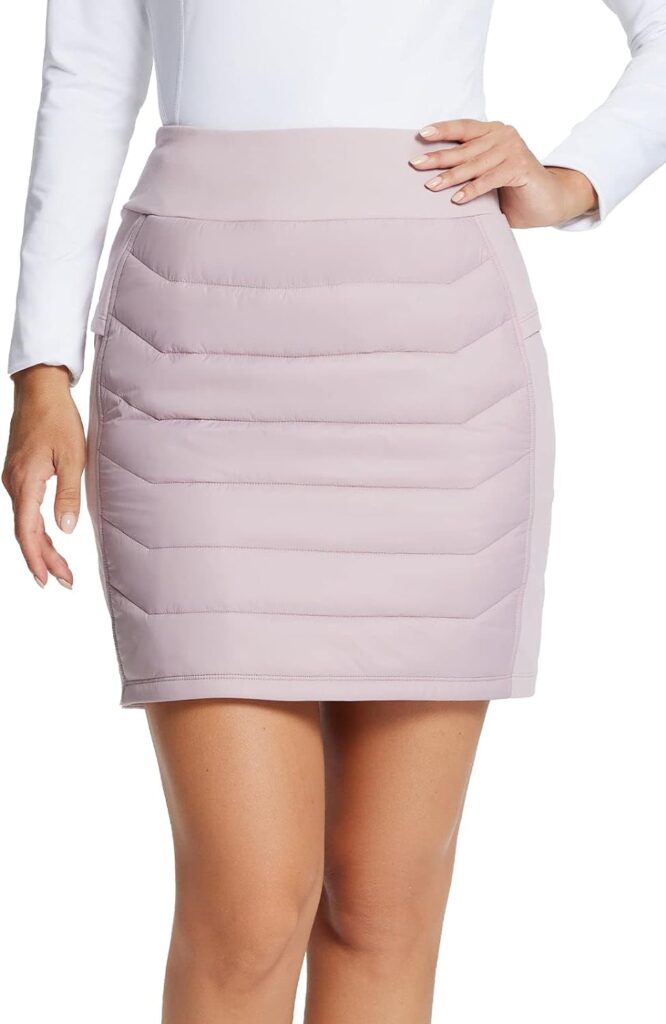
Pros:
- Warm insulation suitable for cold days (10°F- 40°F) with water-resistant nylon fabric.
- Features multiple pockets for essentials and side stretch panels for freedom of motion.
- Lightweight and stretchy material with a fashionable quilted stitching.
- Mid-high waistband design for tummy control and comfort.
Cons:
- The puffer design might not be as versatile for warmer weather or less intensive activities.
- High-rise style may not suit all body types or personal preferences.
3. RBX Active Women’s Long Length Skort
RBX offers a versatile and stylish skort with practical features for active women.
Pros:
- Longer length for versatile wear and full-sized side pockets for easy storage.
- Quick-drying and breathable fabric (92% Polyester, 8% Spandex), ideal for various activities.
- Attached bike short for added coverage and support.
- Elastic waistband ensures a comfortable and secure fit.
Cons:
- The longer length might not be preferred by those looking for a shorter, more traditional skirt look.
- Some may find the drawstring closure less durable or secure compared to other types.
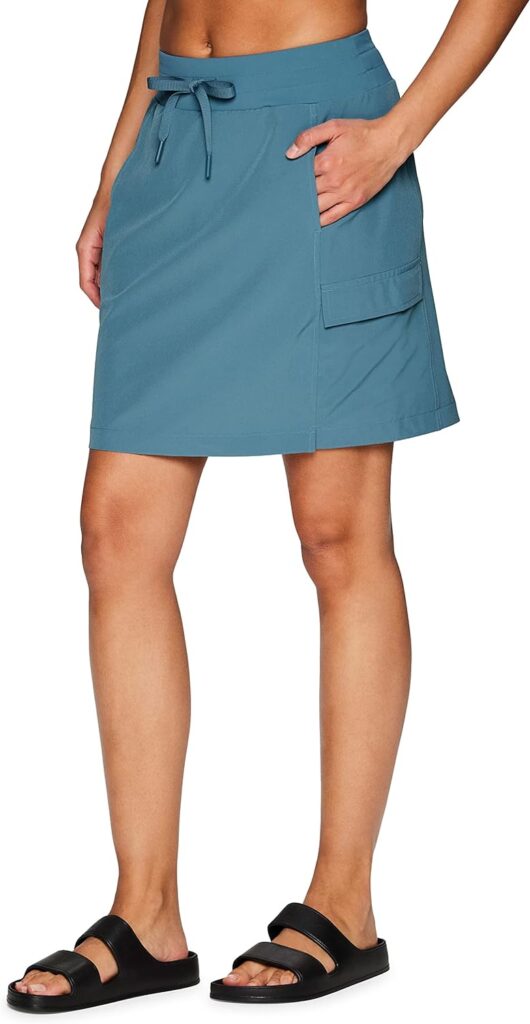
4. BLEVONH Women’s Golf Skirt
BLEVONH offers a knee-length skirt that combines fashion with functionality, making it suitable for multiple activities.

Pros:
- High-waisted design with an elastic waistband for tummy control.
- Three pockets for convenient storage, including two side pockets and one inner pocket.
- 2-in-1 design with mesh built-in inner shorts for moisture management.
- Vibrant design and color options for personal style expression.
Cons:
- Knee-length might restrict movement more than shorter alternatives.
- The specific pattern and color may not appeal to those preferring solid colors or subtler designs.
5. Women’s Hiking Cargo Skort Skirt
This cargo skort skirt is designed for the adventurous woman who values functionality and style.
Pros:
- Ample storage with 2 zippered and 2 large velcro pockets, plus a front loop for essentials.
- Durable, moisture-wicking, and quick-dry fabric (90% Polyester, 10% Spandex) with a 16-inch length for easy movement.
- Soft and wide waistband with external drawstring for an adjustable fit.
- DWR treatment for water repellency and UPF 50+ for sun protection.
Cons:
- The cargo design might be bulkier than other skirts, affecting streamline movement.
- Some might prefer a simpler design without the additional pockets and loops.
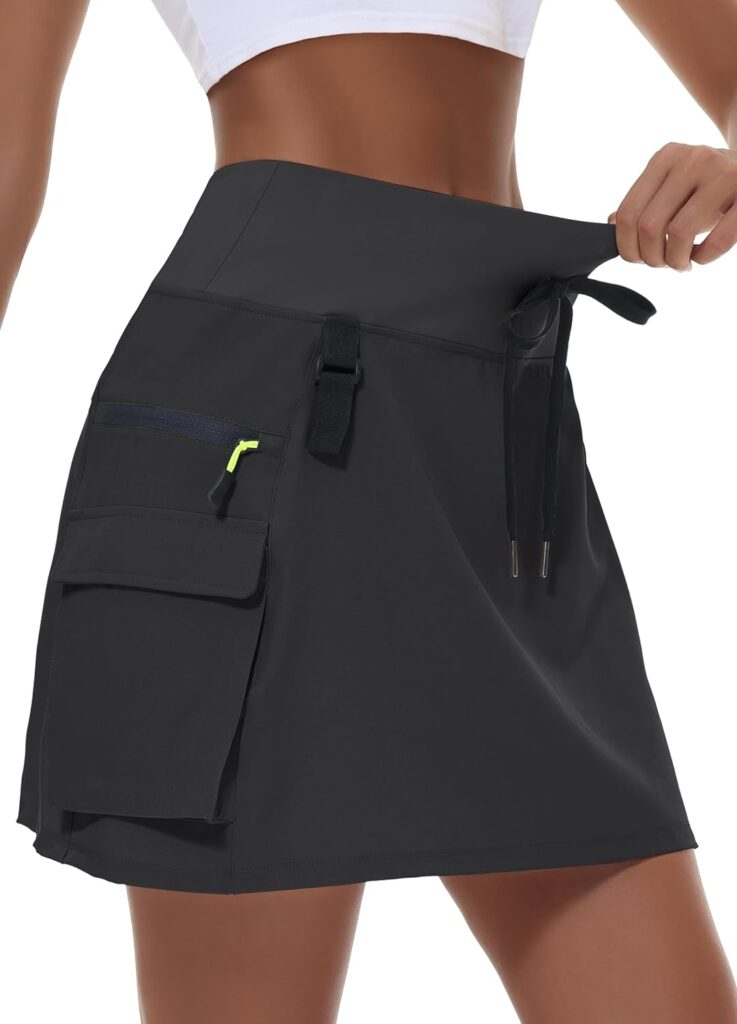
6. Avalanche Women’s Stretch Woven Hiking Skort
Avalanche’s skort is a blend of practicality and simplicity for outdoor enthusiasts.
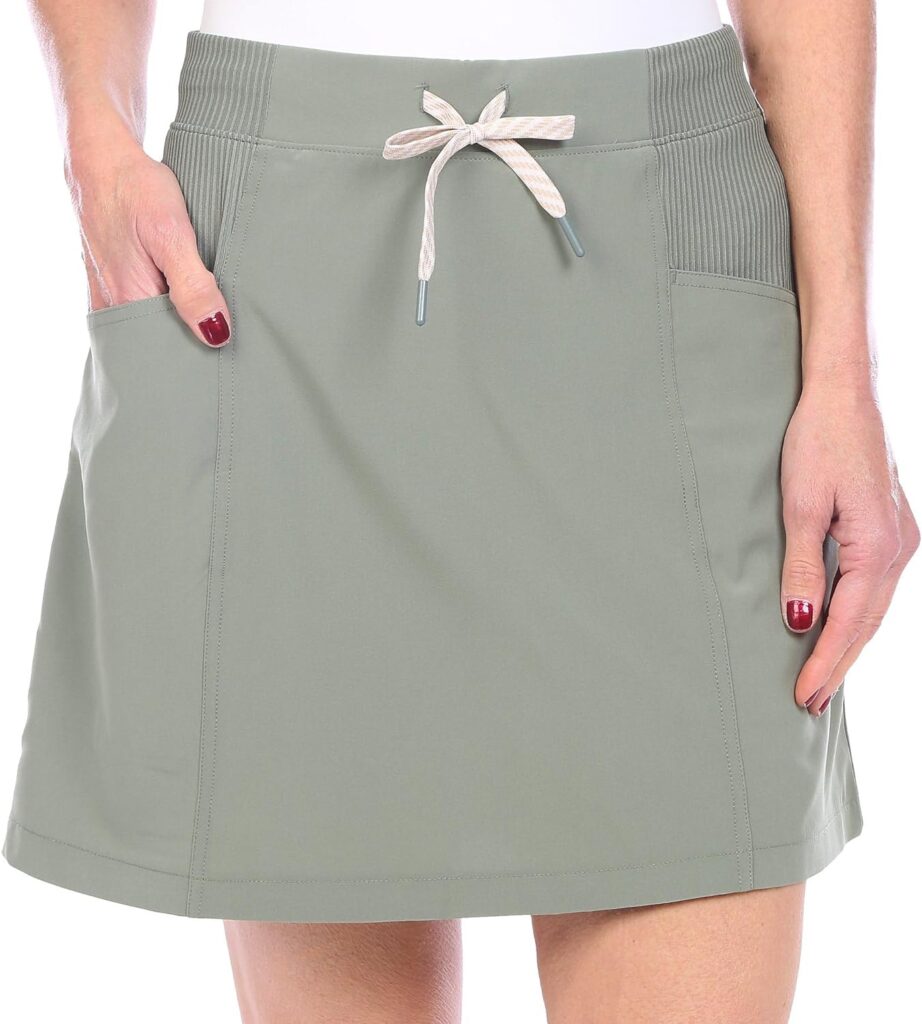
Pros:
- Quick-drying woven fabric (92% Polyester, 8% Spandex) suitable for various outdoor activities.
- Attached biker shorts for coverage and support.
- Functional pockets for essential storage.
- Elastic waistband for a comfortable and secure fit.
Cons:
- Limited color options (Sage Ribbed Side) may not cater to all tastes.
- Some may find the fabric blend less breathable compared to natural fibers.
Hiking Skirts vs. Traditional Attires
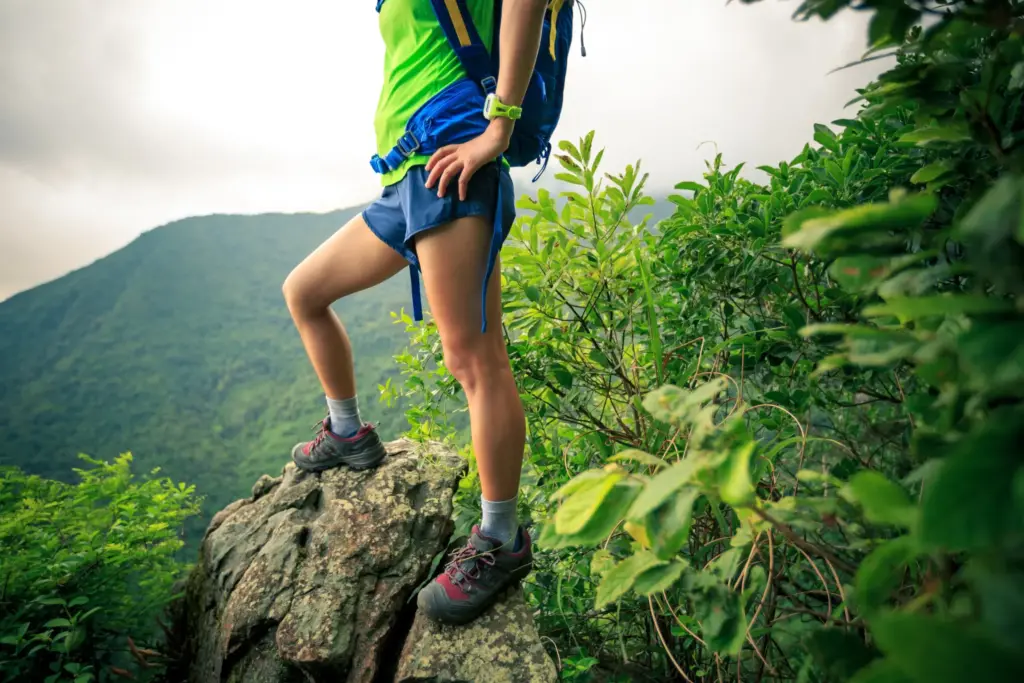
When preparing for a hike, choosing the right attire is as crucial as selecting the appropriate gear. The decision between hiking skirts, shorts, and trousers involves considering various factors such as the climate, terrain, and personal comfort preferences. Each type of hiking attire offers unique advantages, catering to different needs and preferences. Let’s explore the pros and cons of hiking skirts compared to traditional hiking shorts and trousers to help you make an informed decision for your next adventure.
Hiking Skirts
Hiking skirts have gained popularity for their versatility and comfort. Here are their key advantages:
- Unmatched Freedom of Movement: The design of hiking skirts allows for a wide range of motion, making it easier to navigate steep inclines, rocks, and other obstacles.
- Convenience: Skirts offer ease for quick restroom breaks in nature, reducing the hassle compared to more traditional hiking attire.
- Seamless Transition: The style of hiking skirts enables hikers to move effortlessly from the trail to social settings without needing to change.
- Ventilation and Comfort: Especially in warm weather, skirts provide superior airflow, helping to keep you cool.
However, skirts might offer less protection against rough terrain or dense underbrush compared to pants.
Hiking Shorts
Hiking shorts are a staple in many hikers’ wardrobes due to their practicality and comfort. Their advantages include:
- Coverage and Protection: Shorts provide more coverage than skirts, offering a balance of protection against sun exposure and scratches from vegetation while still promoting ventilation.
- Ideal for Warm Weather: The design of shorts is perfect for hikes in hot climates, allowing for excellent air circulation.
- Variety of Styles: Hiking shorts come in various lengths and materials, allowing hikers to choose based on their preference and the trail’s demands.
The limitation of shorts is that they may not offer the same level of freedom of movement as skirts, particularly with longer styles.
Hiking Trousers
For cooler climates or challenging terrains, hiking trousers are often the go-to choice. Their benefits include:
- Protection: Trousers provide full coverage, protecting against cold weather, UV rays, and abrasions from underbrush or rocks.
- Versatility: Many hiking trousers feature zip-off legs, converting them into shorts for temperature control or as the terrain changes.
- Durable Materials: Designed with rugged use in mind, trousers are often made from materials that withstand abrasions and tears.
The downside to hiking trousers is that they can be too warm for hot weather hikes and may not offer as much ventilation as shorts or skirts.
Making the Choice
The decision between hiking skirts, shorts, and trousers ultimately depends on the specific conditions of your hike and personal preferences. Here are some considerations to guide your choice:
- Weather and Climate: Choose attire that will keep you comfortable in the weather conditions you expect to face.
- Terrain: Consider the type of terrain and choose attire that offers the best protection and mobility.
- Personal Comfort and Style: Select the option that you feel most comfortable and confident wearing.
Customization and DIY Options for Hiking Skirts
Hiking skirts offer a unique opportunity for DIY enthusiasts and those who love to personalize their gear. Customizing your hiking skirt not only allows you to add a personal touch but also ensures that your attire meets your specific needs and preferences on the trail. Whether you’re looking to enhance functionality with additional pockets or express your style with custom embroidery, there are numerous ways to make your hiking skirt uniquely yours. Here’s how to get started with customization and DIY options for your hiking skirt.
Adding a Personal Touch through Customization
- Pockets and Storage: One practical customization is to add extra pockets. Choose from zippered pockets for security, mesh pockets for breathability, or hidden pockets for valuables. Consider the items you carry when hiking and customize accordingly.
- Adjustable Waistbands: For enhanced comfort and fit, adding an adjustable waistband, such as elastic with a drawstring, can make your skirt adaptable to different body sizes or layers worn underneath.
- UV-Reflective Materials: Applying UV-reflective materials or choosing fabrics with high UPF ratings can increase your protection against the sun. This feature is particularly useful for those who hike in sunny conditions.
Crafting DIY Hiking Skirts
- Sewing Your Own: For those who are sewing-savvy, creating a DIY hiking skirt from scratch can be a rewarding project. There are plenty of patterns and tutorials available online that cater to various skill levels, from beginners to advanced seamstresses. Select materials based on the features you value, such as moisture-wicking fabrics, stretchy materials for freedom of movement, or durable fabrics for rugged terrain.
- Custom Patterns and Designs: Tailor your skirt to your exact specifications by modifying existing patterns or creating your own. This allows you to adjust the length, fit, and features of your skirt, ensuring it meets your hiking needs perfectly.
Accessorizing Your Hiking Skirt
- Belt Loops and Belts: Adding belt loops can increase the functionality of your skirt, allowing you to secure gear or accessories. Pair with a decorative or functional belt for added style or utility.
- Decorative Patches and Embroidery: Personalize your skirt with decorative patches that reflect your interests, achievements, or affiliations. Custom embroidery can also add a unique touch, whether it’s a simple design, initials, or detailed artwork.
- Reflective Elements for Safety: For those who hike during dusk or dawn, reflective elements can be both a stylish and safety-enhancing addition. Reflective tapes, threads, or patches can increase visibility to others, including motorists if you’re near roads.
Hiking Skirt Maintenance and Care
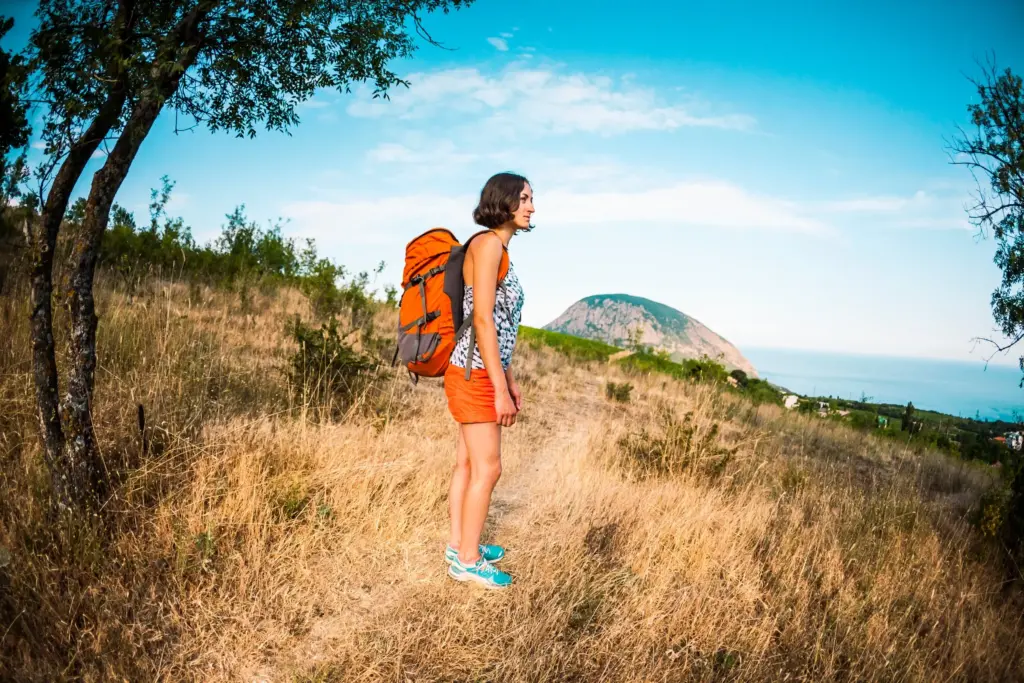
To ensure your hiking skirt remains in top condition, extending its lifespan and maintaining its functionality, proper care and maintenance are crucial. Hiking skirts are designed to withstand the rigors of outdoor activities, but like all specialized gear, they require specific attention to keep them performing at their best. Here are detailed guidelines for the care and maintenance of your hiking skirt, including washing instructions and tips for long-term care.
Washing Instructions
- Machine Washable: Most hiking skirts are designed to be machine washable for easy care. Before washing, always check the garment’s care label for specific instructions related to temperature and cycle recommendations.
- Avoid Fabric Softeners: Fabric softeners can break down the moisture-wicking and breathable properties of performance fabrics, reducing their effectiveness. Instead, opt for a gentle detergent formulated for technical fabrics.
- Close All Fastenings: Before washing, ensure that all zippers, Velcro, and buttons are fastened to prevent them from catching on other items in the load or damaging the fabric.
- Use a Gentle Cycle: Select a gentle wash cycle to prevent excessive wear on the fabric. Cold water is often recommended to preserve the fabric’s integrity and color vibrancy.
- Turn Inside Out: Turning your skirt inside out before washing can help reduce wear and tear on the outer fabric, protecting any decorative elements and maintaining the garment’s appearance.
Drying and Ironing
- Air Dry: Whenever possible, air dry your hiking skirt by laying it flat or hanging it up. High heat from dryers can damage elastic and fabric fibers, leading to shrinkage and reduced lifespan.
- Avoid Direct Heat: If you must use a dryer, opt for a low heat setting. Avoid ironing as high temperatures can damage technical fabrics. If necessary, use a low heat setting and iron the skirt inside out, but always check the care label first.
Stain Removal
- Prompt Treatment: Treat any stains as soon as possible to prevent them from setting. Use a gentle stain remover suitable for the fabric type but test it on a small, inconspicuous area first to ensure it doesn’t cause discoloration.
- Avoid Bleach: Chlorine bleach can damage the fibers of your skirt and affect its color. Opt for a non-chlorine bleach if needed.
Long-term Care
- Storage: Store your hiking skirt in a cool, dry place away from direct sunlight to prevent fading and fabric degradation. If storing long-term, avoid folding it in the same place repeatedly to prevent creases from becoming permanent.
- Repairs: Address any tears or damage promptly to prevent them from worsening. Many outdoor retailers offer repair kits or services specifically for technical apparel.
Skirt Alternatives: Pros and Cons
While hiking skirts have become a popular choice for many outdoor enthusiasts, there are alternative garments that offer similar benefits with their unique twists. Hiking dresses and culottes are two such alternatives, each bringing its own set of advantages and drawbacks to the table. Understanding the pros and cons of these options can help hikers make informed decisions about their attire, ensuring comfort, functionality, and style on the trail. Let’s explore these alternatives in detail, comparing them to hiking skirts to highlight their versatility, weight, and overall suitability for hiking.
Hiking Dresses
Hiking dresses are designed with the outdoor enthusiast in mind, blending the functionality of traditional hiking attire with the simplicity and comfort of a dress.
Pros:
- All-in-One Solution: Hiking dresses offer an uncomplicated, single-piece outfit, eliminating the need for coordinating separate garments.
- Ventilation and Comfort: Similar to hiking skirts, dresses provide excellent airflow, making them ideal for warm weather hikes.
- Versatility: Many hiking dresses are stylish enough to transition from trail to casual outings, making them a versatile option for travelers looking to pack light.
Cons:
- Coverage and Protection: Dresses may offer less protection against rough terrain, underbrush, or insects compared to skirts paired with leggings or trousers.
- Limited Storage: Unlike skirts that can be designed with multiple pockets, dresses may offer fewer options for carrying essentials directly on the garment.
Culottes
Culottes are wide-legged pants that fall somewhere between shorts and skirts in terms of style and functionality. They offer a unique blend of comfort and mobility for hikers.
Pros:
- Freedom of Movement: Culottes’ wide-legged design provides excellent mobility, akin to skirts, but with the added coverage and protection of pants.
- Versatile Styling: They can be as stylish as they are functional, easily paired with various tops and shoes for different looks and activities.
- Practicality: Many culottes come equipped with pockets and belt loops, enhancing their practicality for hiking and other outdoor adventures.
Cons:
- Weight and Bulk: Culottes can be heavier and bulkier than skirts, potentially making them less ideal for long-distance treks where weight and packability are concerns.
- Less Ventilation: Depending on the material and design, culottes may offer less ventilation than skirts, which could be a drawback in hot weather.
Comparison with Hiking Skirts
When compared to hiking skirts, both dresses and culottes offer unique benefits that may appeal to different hikers’ preferences.
- Versatility: Hiking skirts often edge out in versatility, easily pairing with various tops and suitable for a wider range of activities.
- Weight: Skirts tend to be lighter than culottes, making them a preferred choice for hikers conscious about pack weight.
- Adaptability: With the option to pair skirts with leggings, shorts, or even wear them over trousers, skirts provide adaptability to changing weather conditions that dresses and culottes may not.
Environmental Impact and Sustainability in Hiking Apparel
As the world becomes increasingly aware of the environmental impacts of fashion and outdoor apparel, many brands and consumers are turning towards sustainable practices and materials. This shift is not only crucial for reducing the ecological footprint of our clothing but also for ensuring the longevity and ethical production of hiking gear, including hiking skirts. Let’s explore the aspects that make hiking apparel more sustainable and environmentally friendly.
Eco-friendly Materials
- Recycled Fabrics: Brands like Patagonia are leading the way by using recycled materials to create their hiking skirts. This approach significantly reduces waste and the carbon footprint associated with producing new textile fibers.
- Natural Fibers: Materials such as organic cotton or bamboo are renewable and biodegradable, offering a more sustainable alternative to traditional synthetic fabrics.
- Low-Impact Dyes: The use of low-impact, non-toxic dyes minimizes water pollution, making the production process less harmful to the environment.
Sustainable Sourcing
- Ethical Practices: Look for brands that prioritize ethical sourcing, ensuring that the materials used in their hiking skirts are obtained in a way that minimizes environmental harm and supports fair labor practices.
- Certifications: Certifications such as Fair Trade and GOTS (Global Organic Textile Standard) can provide assurance of a product’s sustainable and ethical credentials.
Durability Over Disposability
- Longevity: Investing in a high-quality, durable hiking skirt means it will last for years, reducing the need for frequent replacements and, consequently, the waste associated with disposable fashion.
- Repairability: Choosing brands that offer repair services or that design their garments to be easily repaired can further extend the lifespan of hiking apparel.
Safety Considerations for Hiking Skirts
While hiking skirts provide comfort and freedom of movement, it’s essential to address potential safety considerations associated with their wear.
Tick Protection
- Preventive Measures: Given that skirts expose more skin, there’s an increased risk of tick bites. Treating your hiking skirt with permethrin, a tick-repellent substance, can provide protection. Additionally, wearing tick-repellent clothing underneath the skirt can offer an extra layer of defense.
- Regular Checks: Always perform tick checks after hiking in areas known for tick activity, regardless of the protective measures taken.
Snagging Hazards
- Material Choice: Opting for hiking skirts made from tear-resistant materials can minimize the risk of snagging on branches or undergrowth. Look for skirts designed specifically for rugged outdoor use.
- Trail Awareness: Being mindful of the surrounding vegetation and choosing trails with less dense undergrowth can reduce snagging risks.
Sunburn
- Sun Protection: The increased skin exposure from wearing a skirt necessitates diligent application of sunscreen, particularly on legs and areas not typically exposed when wearing trousers. Consider hiking skirts with built-in UPF protection for additional sun defense.
- Cover Up: In especially sunny conditions or at higher altitudes where UV exposure is greater, pairing your skirt with UV-protective leggings can provide extra protection.
Wrapping Up: My Personal Skirt Adventures
Hiking in a skirt has been a game-changer for me. It combines functionality with a touch of femininity. So, why not give it a whirl on your next hike?
FAQs
- Is a hiking skirt suitable for all weather conditions?
While perfect for warm conditions, in colder weather, you can pair them with leggings. - Do all hiking skirts come with inner shorts?
Not all. Some have them for added comfort, while others are just the skirt. - Can men wear hiking skirts?
Absolutely! They offer the same comfort and benefits, irrespective of gender. - How do I ensure the right fit?
Opt for adjustable waistbands and always refer to the brand’s size guide. - Are they suitable for rugged terrains?
With the right material and fit, hiking skirts are suitable for various terrains.
Resources
https://nailthetrail.com/how-wash-outdoor-clothing/
https://youtu.be/xck-06xIhe8?si=FE0F-6V247pJDD_z




